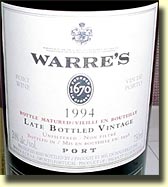
Ok, now some of you know that I'm really into port (then, of course, there's the rest of you, who don't even know who the hell I am :). Well, for my first pick of the week, I present the Barros Colheita 1977. I've bought (and drunk), over the course of 2+ years, two cases of this beauty. And I can tell you that every drop of every bottle was worth whatever I paid (and, actually, I didn't pay over $60.00 per bottle, which is incredibly cheap for this stuff). It's got a warm, rich feel; the first time I tried it, I presumed that it was warm because it had been sitting near the hearth in a restaurant I was in, but it's got that warmth all the time. It's perfect for capping off a good meal and if you can get your hands on a glass of this and a dark chocolate-coated fig, you will be in heaven.
Some may complain, "port, ugh. It's too sweet." Well, that may be true for young ports (like my next recommendation), but a colheita is a tawny port, which has aged for quite a long time. You can tell by the color of the port: tawnies are amber to light brown in color. You can also tell by the nose and the taste. This stuff doesn't overpower either your nose or your tongue; it's subtle and tantalizing, as well as refreshing.
Now, I wish my palette was expanded enough that I could roll off something like, "it has notes of cherry and caramel," but my palette is very limited (at the moment, but I hope to change this in the coming months). All I can tell you is, if you see this, buy it. If not for you, then buy it for me :)
 Next up: Warres LBV 1994. Now, this is a young port. It's strong in the nose and on the palette. This is typical of an LBV (Late Bottled Vintage), since it ages in the bottle and is less than 20 years old. However, it's a vintage grape and is not a blend, unlike many ports. And 1994 was probably the best vintage year in the second half of the 20th century, so anything from this year is good to drink and great to cellar. And this port can be had for less than $20 a bottle, which is a steal. You can probably thank 1997 for that, since it was almost as good a vintage year as 1994 (and has hence brought down the prices of much of the 1994 wine and port that's out there). Unlike the colheita above, this stuff needs to be decanted, as it "throws a crust," meaning that, as the unfiltered port matures in the bottle, bits of grape leaves and such fall to the bottom of the bottle. In order for these bits not to be caught in the glass, you pour the port into a decanter and pour out individual glasses from there.
Next up: Warres LBV 1994. Now, this is a young port. It's strong in the nose and on the palette. This is typical of an LBV (Late Bottled Vintage), since it ages in the bottle and is less than 20 years old. However, it's a vintage grape and is not a blend, unlike many ports. And 1994 was probably the best vintage year in the second half of the 20th century, so anything from this year is good to drink and great to cellar. And this port can be had for less than $20 a bottle, which is a steal. You can probably thank 1997 for that, since it was almost as good a vintage year as 1994 (and has hence brought down the prices of much of the 1994 wine and port that's out there). Unlike the colheita above, this stuff needs to be decanted, as it "throws a crust," meaning that, as the unfiltered port matures in the bottle, bits of grape leaves and such fall to the bottom of the bottle. In order for these bits not to be caught in the glass, you pour the port into a decanter and pour out individual glasses from there.As far as taste goes, this is a young port, so you can distinctly taste the brandy as well as the grapes that have gone into the port. It's not as sweet as say, a ruby port, but you can definitely taste cherries in this one. It's aged in oak barrels for 4 years, then bottled and cellared for an additional five years, but that's a wee babe in terms of ports.
In any event, this stuff is tasty--bottles tend to go quickly at my place, especially if I have company--and will only get better as the years go on. I've ordered a case (that's 12 750ml bottles for the uninitiated), which I will cellar (in my apartment, the wine cellar is an extra closet I have; it's dark, somewhat temperature-controlled and, best of all, I tend to forget that I put stuff in there, so I don't drink it all too soon ;) and drink later. And, at less than $20.00 per bottle retail, almost anyone can afford this. I recommend getting some to try. You won't regret it!


No comments:
Post a Comment